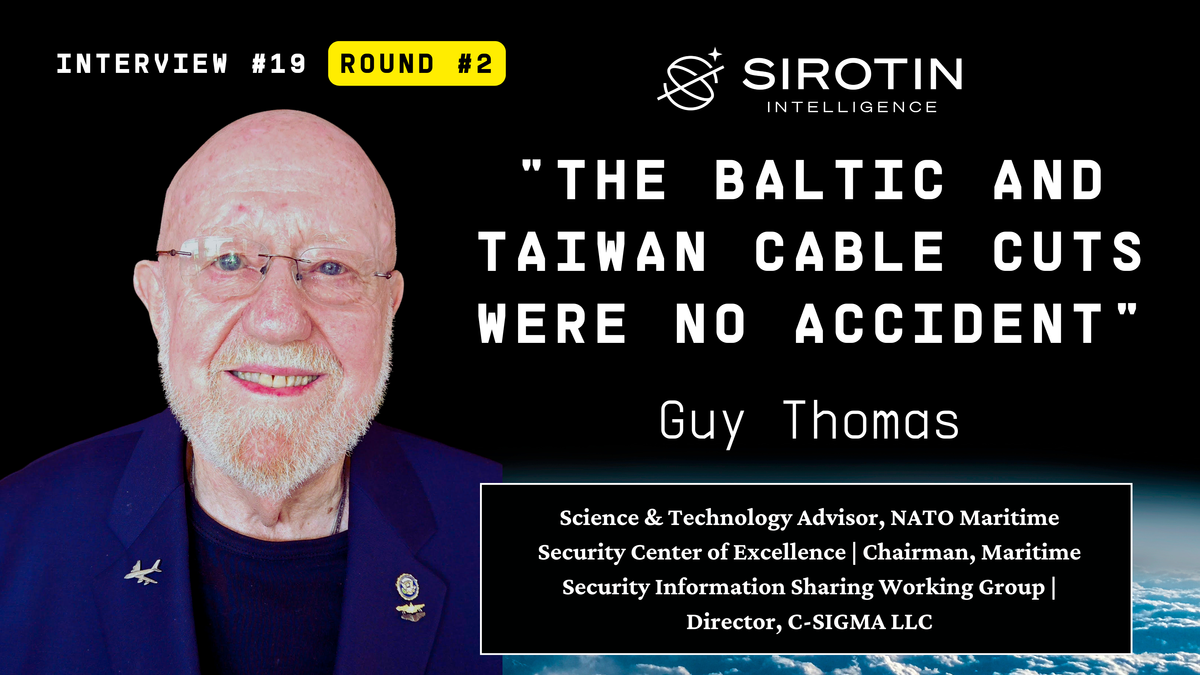"The Baltic and Taiwan Cable Cuts Were No Accident": S-AIS Inventor Guy Thomas on Detecting Today's 'Grey Zone' Maritime Operations and Why We're Losing the Subsea Infrastructure War
Maritime expert Guy Thomas reveals deliberate Russian and Chinese attacks on undersea cables while discussing how unmanned drones are transforming maritime infrastructure security. Thomas shares strategies for protecting critical subsea assets against growing "grey zone" threats.

Beneath the waves, a new form of warfare is unfolding. Critical undersea cables in the Baltic Sea have been mysteriously severed—acts that maritime surveillance expert Guy Thomas identifies as deliberate Russian operations. And China appears to be adopting similar tactics off Taiwan. In probable response to these clandestine operations, the Pentagon has accelerated procurement of 120 sea drones annually starting in 2025. While maritime surveillance drones have appeared in Panama's waters, their utility goes far beyond counter-drug interdiction. Counter surveillance of maritime hybrid warfare operations is probably high on their priority list.This silent battle for control of maritime infrastructure represents one of today's most urgent yet under-reported security challenges.
Guy Thomas brings extraordinary credentials to analyzing these maritime security threats. A retired U.S. Navy Commander with 23 years in intelligence collection operations, Thomas achieved the remarkable distinction of being the first officer to qualify across all four domains: surface ships, submarines, aircraft, and space systems. During his naval career, he participated in 28 MiG engagements during the Vietnam War, conducted classified submarine missions against Soviet targets, and led the operational testing of the Navy's EP-3E and the Air Force's RC-135W reconnaissance aircraft. After his military service, Thomas continued his contributions as a civilian, inventing Satellite AIS (S-AIS) in 2001—technology that revolutionized global maritime surveillance by enabling the real-time tracking of ships worldwide. As the architect of the C-SIGMA initiative (Collaboration in Space for International Global Maritime Awareness), Thomas also contributed to the 2005 National Maritime Security Strategy and was a key author of the maritime provisions in the 2010 U.S. National Space Policy. Today, he serves as Chairman of the Maritime Information Sharing Working Group within NATO's Combined Joint Operations from the Sea Centre of Excellence.
In this exclusive interview, Thomas reveals how unmanned surveillance technologies are evolving to counter maritime threats, why current infrastructure protection efforts are failing, and what specific actions must be taken to build the global maritime security coalition necessary to protect the underwater systems that power our interconnected world.
The recent sightings of sail drones in Panama suggest growing deployment of these platforms. Having mentioned that sail drones and wave gliders have been used for clandestine coastal surveillance off Somalia and likely for counter-drug operations off Mexico, how do you see these unmanned surveillance platforms evolving in the next decade, particularly in terms of their autonomy, endurance capabilities, and sensor integration?
The sightings in Panama are not part of some clandestine intelligence operation as some have speculated. It's part of an openly acknowledged operation to detect, identify, and track all ships and boats before they reach the U.S. Economic Exclusion Zone, which extends from the coastline to 200 miles offshore. To effectively track vessels, we need to begin surveillance well before they enter the EEZ—ideally tracking ships from their departure port to their destination. This comprehensive tracking gives us the best chance to determine if vessels are engaged in illegal operations.
Saildrone has been operational for over a dozen years, with continuous upgrades to its sensors and communications systems as new technology becomes available. Currently, about 20 saildrones are reportedly deployed in the Gulf of Mexico south of Texas and in the Pacific south of California.
Looking ahead to the next decade, I anticipate significant evolution in three key areas:
First, autonomy will advance dramatically. These platforms likely already have tri-modal AIS capabilities (on-off-receive only) with intelligent features like automatic collision avoidance. The AIS system was designed to prevent collisions, so a logical upgrade would allow the AIS to switch from "receive only" to "on" mode when a collision is possible. When returning to base or ready for pickup by a "mothership," the AIS switches fully on. Future autonomy will incorporate more sophisticated AI for independent threat assessment and mission adaptation.
Second, endurance will continue to improve, though it's already impressive. These systems use wind and solar energy for power, eliminating the need to "return to base to refuel," which makes them extremely cost-effective to operate. Advances in energy harvesting and storage will likely extend operational duration even further.
Third, sensor integration will become more sophisticated. Saildrone's primary value is in filling the data gaps that other surveillance systems miss. Their low signature makes them difficult to detect while performing this critical function. We'll see tighter integration with the rapidly expanding Earth observation satellite systems, including synthetic aperture radar (SAR), optical sensors in visible and IR spectrums, electronic intelligence (ELINT), and "night lights" detection.
As the inventor of Satellite AIS (S-AIS), how do you assess the integration of AIS technology with these unmanned surveillance systems? You noted helping develop "tri-mode AIS" - could you elaborate on how this technology enhances maritime domain awareness compared to traditional systems?
The first commercial S-AIS constellation was launched by ORBCOMM in June 2008, and it has fundamentally transformed maritime surveillance. S-AIS tracks and identifies nearly all legal ships worldwide with a refresh rate of just a few minutes. When coupled with terrestrial AIS, it allows us to define global patterns of legal maritime operations.
This pattern recognition has enabled the development of numerous AI-driven software tools that can detect anomalies. The technology has become so sophisticated that we can not only detect offshore fishing boats but also identify specific fishing methods being used—trawling, seining, longlining, etc. Similarly, we can often identify smuggling patterns, though not always with perfect reliability. This capability also extends to sanctions avoiders and the ships that damaged the undersea cables.
The tri-modal AIS technology likely used by Saildrone represents a significant enhancement over traditional systems. In "receive only" mode during patrol, it can monitor AIS-equipped vessels without revealing its own position. When a potential collision is detected, it can automatically switch to "on" mode to prevent accidents. When returning to base or awaiting pickup, it operates in full transmission mode.
This approach provides three critical advantages:
- First, it maintains operational security by minimizing electromagnetic emissions that could compromise the platform.
- Second, it preserves situational awareness by continuously monitoring AIS-equipped vessels.
- Third, and perhaps most importantly, it enables integration with the global surveillance picture. S-AIS data makes all other satellite observation capabilities more useful by providing identification and routing information for legal ships. This integration has led to at least a dozen commercially available tools that fuse, analyze, and display data from all satellite systems with maritime surveillance capabilities. Some of these tools also incorporate data from terrestrial, aviation, and land systems, and some even "scrape" the internet for additional related information.
Both the Baltic and Taiwan Strait incidents demonstrate the vulnerability of critical subsea infrastructure to "grey zone" activities. If you were advising the administration on developing a comprehensive protection strategy for these assets globally, what would be your primary recommendations?
In recent months, we've witnessed alarming incidents where undersea cables in the Baltic and off Taiwan have been damaged. All evidence points to intentional action by ships under Russian and Chinese control. The pattern suggests this wasn't a coordinated effort between Russia and China; rather, China observed Russia's actions and decided to conduct similar operations—"If Putin can do this, then so can I!" This pattern may mirror Russia's approach in Ukraine: if Putin succeeds there, Taiwan may face similar challenges.
These attacks demonstrate that all maritime infrastructure—including undersea cables, communications structures, and oil facilities—is highly vulnerable to clandestine attack. The vastness of the ocean gives significant advantages to wrongdoers.
My primary recommendations for a comprehensive protection strategy would focus on:
- First, develop a global collaborative response. Space systems cannot do it alone, nor can unmanned maritime surveillance systems like Saildrone and Waveglider. We need a globally coordinated effort across all nations of goodwill to build and operate the necessary systems to protect the maritime domain from "gray zone" warfare by outlaw states like Russia, Iran, and North Korea, as well as non-state terrorists. This collaboration would also have significant additional utility for maritime safety and security.
- Second, implement the C-SIGMA concept (Collaboration in Space for International Global Maritime Awareness) that I've advocated since 2005. While space systems can't do everything, maritime surveillance is impossible without them. In June 2010, President Obama ordered the USA to create and lead such a coalition, but unfortunately, the retired US Coast Guard captain tasked with execution decided not to implement the order for unknown reasons—a decision that remains both puzzling and frustrating.
- Third, establish firmer connections between the numerous existing regional maritime security centers. The European Union has FRONTEX and EMSA. The USA operates JITF South and JITF SW at various security levels. Singapore maintains its Maritime Crisis Center (SMCC) and Information Fusion Center (IFC). India has developed IFC-IOR. The Gulf of Guinea operates the Interregional Coordination Centre in Cameroon and multiple Regional Centers for Maritime Security. The international Maritime Security Council is another resource. Someone needs to bring these organizations into a cohesive global collaboration.
The need for such a system becomes more evident with each passing day.
The Pentagon recently issued a solicitation for private companies to deliver small sea drones with production capacity of 120 vessels per year starting in April 2025. As someone who helped conceptualize maritime surveillance systems, what capabilities would you prioritize in these platforms to maximize their effectiveness in potential conflict scenarios?
The Pentagon clearly recognizes the utility of platforms like Saildrone, as evidenced by their solicitation for small sea drones with production capacity of 120 vessels per year starting April 2025. These systems have proven their value in peacetime maritime border protection, but their utility in combat scenarios depends on specific capabilities.
For maximizing effectiveness in conflict scenarios, I would prioritize:
- First and foremost, low-probability-of-detection communications. These systems would only be useful in combat if they can be equipped with electronic communications that are hard to detect, especially when transmitting surveillance data. Otherwise, they will be quickly detected and destroyed. If this capability exists—and it might—then unmanned maritime surveillance systems could play a significant role in maritime combat.
- Second, minimal physical and electronic signatures. Saildrone already uses wind and solar energy, giving it extended endurance and a relatively low profile. However, Waveglider offers even greater stealth, using wave action for propulsion and solar energy for its sensors and communications. Without a sail, it's extremely difficult to detect, even by units aware of its presence in an area. Further reducing acoustic, thermal, and radar signatures should be a priority.
- Third, mission flexibility and risk tolerance. These platforms could undertake surveillance missions that would be risky for submarines and foolhardy for airborne reconnaissance systems, whether manned or unmanned. Their low cost and unmanned nature mean they can be deployed in high-threat environments where we wouldn't risk more expensive assets or human operators.
- Fourth, advanced sensor integration. Saildrone's primary value is in filling the data gaps that other surveillance systems miss. In a conflict scenario, this capability becomes even more critical as adversaries attempt to operate in ways that avoid detection by conventional systems.
You helped develop the C-SIGMA initiative for international maritime awareness - what diplomatic approaches would you recommend to the current administration for building a more cohesive coalition of Indo-Pacific partners against Chinese maritime coercion?
Since 2005, I've advocated for C-SIGMA (Collaboration in Space for International Global Maritime Awareness) to gather global support for maritime security. While I've always acknowledged that space systems alone are insufficient, maritime surveillance is impossible without them. The growing synergy between space-based systems and maritime drones offers new opportunities for comprehensive maritime domain awareness.
For building a more cohesive coalition of Indo-Pacific partners, I recommend:
- First, revive and properly execute the directive issued by President Obama in June 2010, which ordered the USA to create and lead a global maritime surveillance coalition to provide global maritime awareness. Unfortunately, the person tasked with execution—a retired US Coast Guard captain working in the Secretary of the Navy's office—decided not to implement the President’s order for unknown reasons. This directive provides a ready framework for action.
- Second, identify the appropriate organization to lead this effort. The United Nations seemed a logical choice, but after years of discussions with various UN elements, no one there has been willing to take up this task. Other potential coordinators include the European Union's FRONTEX and EMSA, the USA's Joint International Task Forces, or regional centers like Singapore's SMCC and IFC or India's IFC-IOR.
- Third, leverage the Maritime Security Centre Indian Ocean (MSCIO) and Singapore’s Information Fusion Center (IFC) as a foundation for Indo-Pacific cooperation. These existing structures could be expanded with additional resources and partnerships. Eventually, one center would probably need to be selected as the primary, but both are already very useful in providing regional maritime awareness and could be expanded to establish global maritime awareness.
- Fourth, emphasize shared vulnerability to infrastructure attacks. The incidents in the Baltic and off Taiwan demonstrate that Russia and China are already engaged in grey zone operations targeting critical undersea infrastructure. This common threat provides a compelling rationale for partnership, particularly for nations in the Indo-Pacific region with extensive maritime borders and critical undersea assets.
The world has many regional maritime security centers, but we need someone, somewhere, to bring them all into a global collaboration. The need becomes more evident daily, especially in the face of increasing Chinese maritime coercion in the Indo-Pacific region.
About Guy Thomas
Guy Thomas is a globally recognized expert in maritime security, intelligence operations, and space-based surveillance systems. With over six decades of service and expertise, Thomas has been instrumental in creating the systems and strategies that define modern maritime awareness and global security.
A retired U.S. Navy Commander, Thomas dedicated 23 years to intelligence and reconnaissance operations, serving in hostile environments on ships, submarines, and aircraft. As one of the first U.S. Navy officers designated as a space operations sub-specialist, he was the first to achieve quadruple qualifications across surface, submarine, air, and space domains. Throughout his service, Thomas operated in high-stakes Cold War missions, participated in 28 MiG encounters with nearly 20 successful engagements, and contributed to classified intelligence collection efforts. His career highlights include leading the operational testing and evaluation of the Navy's EP-3E reconnaissance aircraft and bringing to life the Air Force's RC-135V/W Rivet Joint Block III fleet of 16 aircraft, advancing airborne intelligence capabilities. He also contributed to the development of classified and tactical intelligence systems, including the conception of the Tactical Information Broadcast System (TIBS) and helping to create the Integrated Broadcast System (IBS).
Thomas is the inventor of Satellite AIS (S-AIS), a transformative technology enabling global ship tracking and improving global maritime safety and security. This innovation has been widely recognized as one of the most significant maritime advancements since radar. Building on this achievement, he conceived and developed C-SIGMA (Collaboration in Space for International Global Maritime Awareness), an international initiative that integrates unclassified space-based systems to enhance maritime situational awareness. C-SIGMA, which remains a cornerstone of global maritime awareness, directly supports U.S. National Space Policy (2010) and fosters international collaboration to improve safety, environmental protection, and resource conservation.
A pivotal contributor to the National Maritime Security Strategy (2005) and the National Maritime Domain Awareness Technology Roadmap (2005), Thomas played a central role in shaping the international approach to maritime domain awareness, with these documents having far-reaching impact beyond U.S. borders. While Task #1 of the U.S. National Space Policy Implementation Directive (2010) focused on international cooperation in utilizing space systems for maritime safety and security, its implementation was unfortunately shelved due to unknown internal disagreements.
Currently, Thomas serves as Chairman of the Maritime Situational Awareness Working Group within NATO ACT Combined Joint Operations from the Sea Centre of Excellence, which operates under the leadership of a U.S. Navy 3-star admiral and British Commodore deputy. In this role, he facilitates collaboration among international stakeholders to address maritime security, environmental, and economic challenges. As an advisor to the NATO Maritime Security Centre of Excellence in Istanbul, Turkey, Thomas continues to contribute to the development of NATO's maritime strategies, enhancing global coordination in maritime surveillance and situational awareness.
Thomas's contributions have earned him numerous accolades, including the USGIF Individual Achievement Award (2015) for advancing space-based maritime awareness and multiple nominations for the National Medal of Technology and Innovation and the Space Technology Hall of Fame. As an author, he has published foundational works, including "A Silent Warrior Steps Out of the Shadows” and “New Sentinels of the Seas – Satellite AIS and the Birth of Global Maritime Awareness.”





